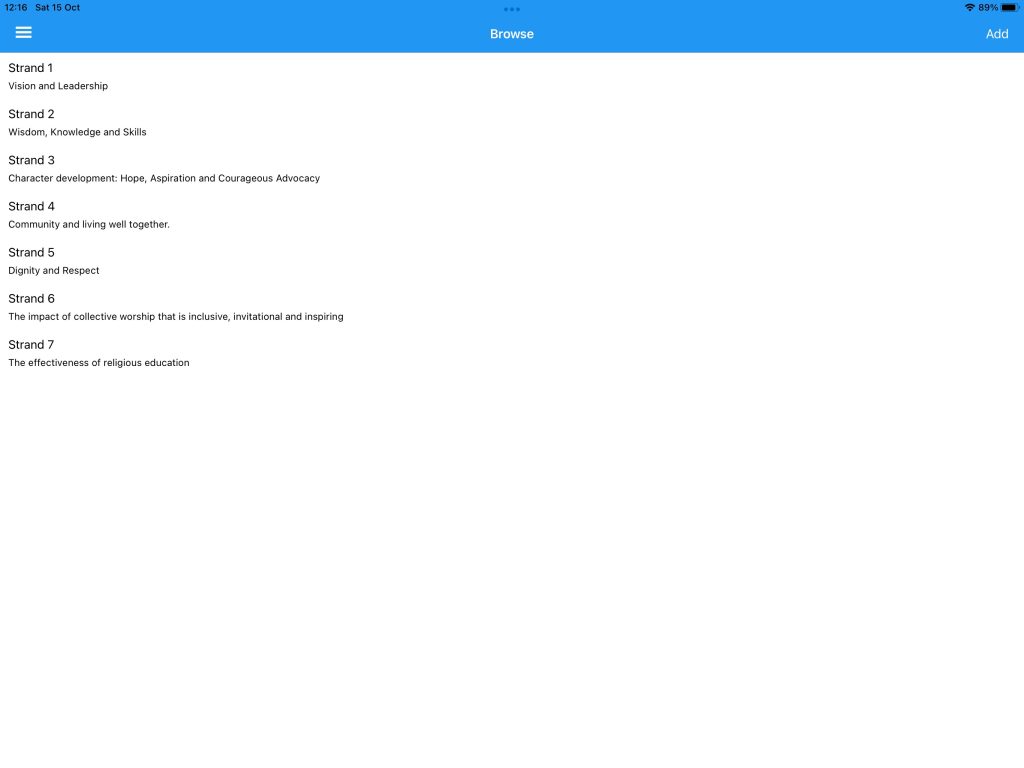1 – Sharing of Best Practices across various branches of an organisation/health care provider/educational establishment.
The idea behind this project is to share best practices between various branches of an organisation/company/health care provider/educational organisation/charity.
Each organisation will have a set of unique requirements/standards that each organisation has to try and adhere to. Allowing various branches within the organisation to share best practices will undoubtedly lead to a better company with improved productivity.
In a similar manner, best practices can be shared within the various branches of a health care company and/or hospital adhering to the Quality Care Commission standards.
Likewise, best practices can be shared within the various schools in the UK that are measured according to the Church of England’s SIAMS requirements and the board of education’s OFSTED requirements.
For the purpose of this presentation/demonstration I have chosen to use the Church of England SIAMS requirements for Church of England primary schools in the UK, to demonstrate the effectiveness of the idea.
The purposes of this app are listed below:
- After breaking down a list of requirements/specifications/goals/standards for important organisations into manageable activities/tasks, a company can measure its own performance by scoring itself against best practises shared by other similar organisations prior to an official audit by the organisation.
- This app would use Azure web services to store and update best practices suggested by each organisation as they assess themselves against existing best practices
- The app would cultivate a spirit of collaboration across all departments in an organisation without being too dogmatic in its approach.
- The shared best practices would allow companies to benefit greatly and improve productivity and performance.
- The app is intended to be easy to use, breaking down activities into groups or strands of commonality.
An initial prototype has been created for Church of England schools in the UK assessing their performance against the requirements (SIAMS).
Help towards the cost of Azure hosting is vital to the success of this project.
Technologies used are Xamarin for the front end (moving to .NET Maui later) and Azure web services /entity framework for the back-end data services / data updates.
This project is being developed by myself with valuable input from school teachers/school governors.
An A3 chart is used to break the requirements down into manageable activities within common themes.
The app then allows the user to score their performance against each requirement, depending on how many of the best practice examples they are following. Simply checking against existing best practices will allow for sharing of ideas. The user can then submit their own best practice examples for additional scores.
Finally a leader board is used to show which user has submitted the most best practices that have been integrated into the list of accepted best practices within the app.
An Azure back end database is used via web services to ensure all client apps are up to date with the latest best practice examples.
Administrators are identified within each organisation/institute. They will each have overall control over identifying and accepting best practice submissions within the app.
Screen shots of the app:

After breaking the requirements down into groups of common themes, the theme headings should be displayed on the ‘strands’ page.

The Requirements page, breaks down the themed requirements into the activities/tasks that are to be measured and for which best practices can be scored / submitted.

The details page is the page where the user will submit their own best practice examples, and score themselves on existing performance by selecting every best practice example that they are currently following.
Once a best practice example is submitted, it is stored on the Azure hosting provider and will be reviewed by the organization administrator. The app will have an extra page only visible to the administrator, that will allow every best practice to be reviewed and moved (where appropriate) into the list of official best practices for that organization.
Finally a leaderboard is also shown displaying the branch within the organization/educational institute/health care provider that has submitted the most number of best practices and another leaderboard showing the branch that has had the most number of best practice submissions that have become accepted best practice examples.